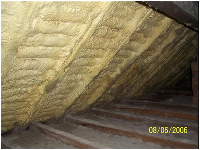Spray-on roof repairs should be avoided – unless your home is really about to fall down
Q. Every year gusts of wind dislodge one or two of my roof slates. The roof is in its original 1920s condition with no under-felt. There are adverts in the papers for a ‘foam spray solution’ for old roofs. These are guaranteed for twenty or so years. Is this the easiest way forward, or should we look to get the whole roof redone?
A. The fact that slates are slipping every year probably indicates that the nails which hold them to the timber battens are rusted through. Roofers refer to this as nail fatigue or nail sickness, and it is definitely time to have the roof stripped off and re-covered. Having foam sprayed on to the undersides of the slates may sound like a wonderful high-tech solution but it is actually a bad idea. It is at odds with the recommendations of the Building Regulations, which require a clear 50mm ventilated gap between insulation and roof covering. The foam sets hard and removes the two vital attributes that allow a traditional roof to last and perform so well for so long – the ability to breathe and the ability to move. The foam completely encloses the timber battens and the top surfaces of the rafters, which might cause them to rot. It also sticks tight to the slates and makes it almost impossible for them to ever be re-used. You will also probably find that the cost of the spray-on foam solution will be three or four times that of having the roof re-covered in the traditional way. Try to find a roofer who will remove the existing slates carefully, and re-use as many as possible. Also make sure that the roofer uses a breathable sarking felt, and allows it to sag between the rafters. The ridge tiles and any hip tiles should be rebedded using lime-and-sand mortar to match the original; do not allow the roofer to use sand-and-cement.




